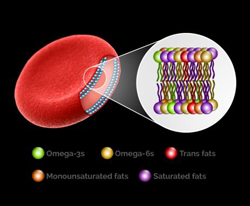
The Omega-3 Index Complete Test also known as cellullar inflamation testing. It gives you a snapshot of the fats that make up our cells. The test mesures the following:
- AA / EPA ratio
- Omega-3s
- Omega-6s
- Saturated fats
- Monounsaturated fats
- Trans fats
- Omega 3/ Omega 6 ratio
What is Cellular Inflammation
Its measuring your future wellness. Your future wellness is too important to guess about it, that’s why you should always test.
Cellular inflammation is the type of inflammation that is below the perception of pain. What it does is disrupt hormonal signaling at the cellular levels that leads to increased fat accumulation, acceleration of the development of chronic disease, and decreased physical performance. You can’t feel cellular inflammation, but you can measure it. The only way to measure cellular inflammation is by testing the ratio of two essential fatty acids (AA and EPA) in your blood.
What is the AA/EPA Ratio?
The AA/EPA ratio is an indication of the levels of cellular inflammation in your body. A high level of cellular inflammation does not mean you have a disease state, but it does indicate that you are not as well as you could be. Your future state of wellness can be determined by the levels of cellular inflammation in the blood as shown below.
| AA/EPA Ranges | Cellular Inflammation | Future state of wellness |
|---|---|---|
| 1.5 to 3 | Low | Excellent |
| 3 to 6 | Moderate | Good |
| 7 to 15 | Elevated | Moderate |
| > than 15 | High | Poor |
AA/EPA RATIO : IDEAL RANGE 1.5 - 3
A good AA/EPA ratio would be 3, and the ideal ratio is about 1.5. You might ask where numbers came from. If you ask who are the longest-lived people in the world today, the answer is the Japanese. If you ask who are the people with the longest health span (longevity minus years of disability), the answer is again the Japanese. If you ask who has the lowest levels of heart disease in the world, the answer again is the Japanese. And you would not be too surprised to find out that the Japanese have the lowest rates of depression in the world today.
When you look at the blood of the Japanese population, the AA/EPA ratio ranges from 1.5 to 3. For example, if your AA levels are 9% and your EPA levels are 4%, then your AA/EPA ratio would be 2.2 which is mid-range for ideal management of cellular inflammation. For comparison the average “healthy” American has an AA/EPA ratio of 18. This means Americans are not only the fattest people in the world today, but also the most inflamed. If the AA/EPA ratio is greater than 3: Increasing the level of EPA in the blood through Krill Oil supplementation and simultaneously decreasing the levels of AA in the diet will help bring this into an ideal range.
Can your AA/EPA ratio be too low? The answer is yes. If the AA/EPA ratio is too low, you might not be able to mount an appropriate inflammatory response when you need to. If the ratio is about 0.7 (as it is in the native Eskimo population), you will be more prone to infections. If it drops to 0.5, the risk of hemorrhagic stroke increases. This is why I like to keep the lower limit of the AA/EPA ratio to 1.5 as found in the Japanese population. If this is the case, consider decreasing your dosage of fish oil.
The 4 Most Important (but Ignored) Blood Tests for Your Heart
- Omega-3 Index
- CRP (C-Reactive Protein)
- Insulin
- Triglyceride/HDL ratio
Omega-3 index
The omega-3 index is defined as the amount of EPA plus DHA in red blood cell (RBC) membranes expressed as the percent of total RBC membrane fatty acids. The EPA + DHA content of RBCs correlates with that of cardiac muscle cells, and several observational studies indicate that a lower omega-3 index is associated with an increased risk of coronary heart disease (CHD) mortality. It is therefore proposed that the omega-3 index be used as a biomarker for cardiovascular disease risk, with proposed zones as below:
Acceptable Omega-3 Levels:
- Lower risk = 8% or higher
- Medium risk = 4 to 8%
- Higher risk = under 4%
CRP (C-Reactive Protein)
C-Reactive Protein is an indicator of inflammation. CRP is released from the liver in response to inflammation.
Acceptable CRP Levels:
- Lower risk: less than 1.0 mg/L
- Average risk: 1.0 to 3.0 mg/L
- Higher risk: above 3.0 mg/L
- Above 10 mg/mL usually indicates acute inflammation
Insulin
Insulin is the hormone that manages your blood sugar levels and your fat metabolism. Insulin spikes and falls based on what you eat.
Acceptable Fasting Insulin Levels: Aim for 4 uIU/ml or lower. The average American is above 8.
Triglyceride (TG)/HDL Ratio
Ok - this is not an actual test. Your regular lipid panel already has your Triglyceride (TG) and HDL numbers. By dividing the Triglyceride number by the HDL you get a ratio that is very informative.
Acceptable TG/HDL Levels:
- If your TG/HDL ratio is less than 1, you are at lower risk.
- 1 to 3 represents medium risk.
- 3 or higher may mean that you are at high risk and insulin resistant.





